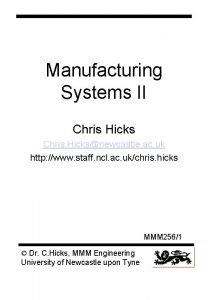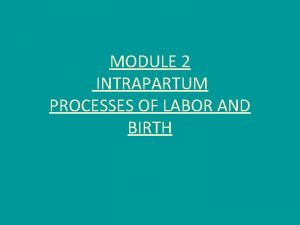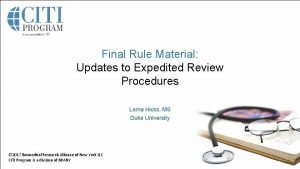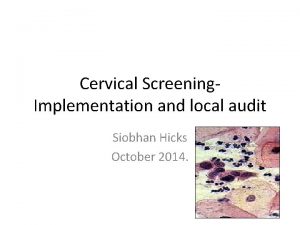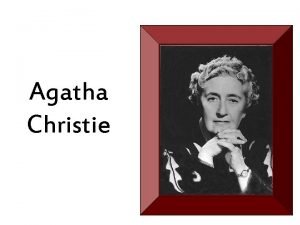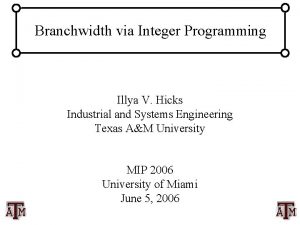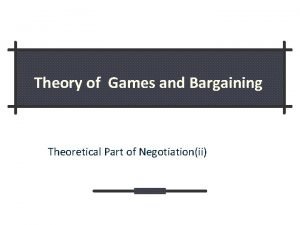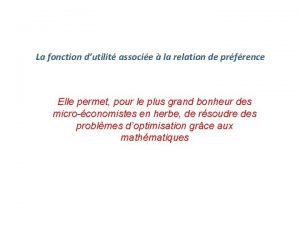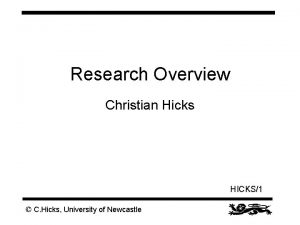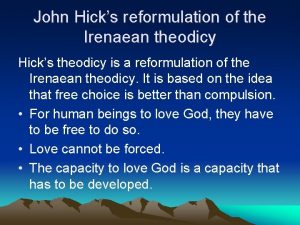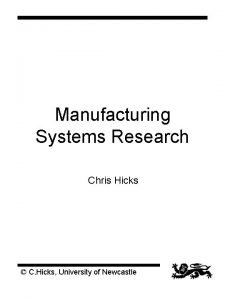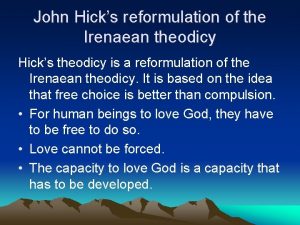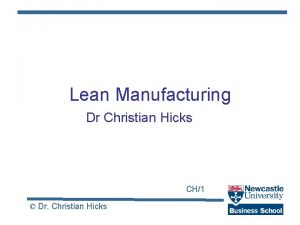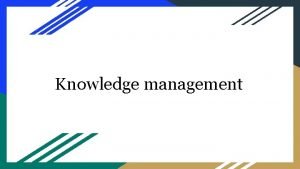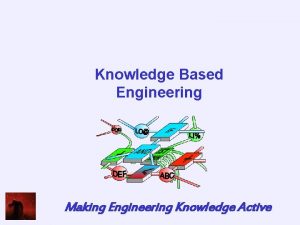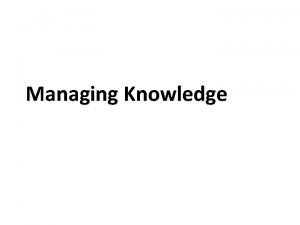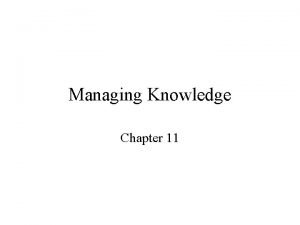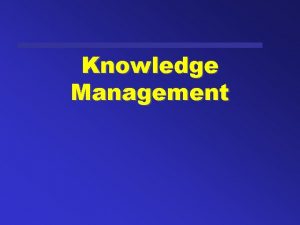Knowledge Management An Engineering Perspective Dr Christian Hicks
















- Slides: 16

Knowledge Management: An Engineering Perspective Dr. Christian Hicks Professor Paul Braiden University of Newcastle upon Tyne EDIN/1 © C. Hicks / P. M. Braiden

Capital Goods Companies • Products and processes usually complex • Customised to meet individual customer requirements • Engineered-to-order • Low volume, “lumpy”, erratic demand EDIN/2 © C. Hicks / P. M. Braiden

Classification of ETO Companies • Product / project focus • “Normal” / “Radical” design • Established / ad-hoc business processes EDIN/3 © C. Hicks / P. M. Braiden

ETO Challenges • Focus on return on capital has led to change in ETO company structures. • ETO companies need to coexist in several alliances / joint ventures simultaneously. • Need to assure the processes by which knowledge is used within the firm and supply chain. • Knowledge needs to be gathered from transitory supply chain relationships • Need to comply with regulatory / deregularity environments. EDIN/4 © C. Hicks / P. M. Braiden

ETO Processes • Physical / non-physical. • Multistage - tendering, contract execution, operations, maintenance. • All processes complex, interrelated and knowledge based. • Processes dynamic and often reconfigured. • General shift towards the outsourcing of physical activities. EDIN/5 © C. Hicks / P. M. Braiden

Product Development Process • 75 -80% of cost and delivery commitments result from early stages design decisions • There is high levels of uncertainty and sparse knowledge. • A holistic view of multistage processes is required including design, manufacture, construction, operation and maintenance • Tendering is often subject to severe time pressure and resource constraints. EDIN/6 © C. Hicks / P. M. Braiden

EDIN/7 © C. Hicks / P. M. Braiden

Product Development Processes • Normal design - product development, modification of existing products • Radical design - creation of new type of product, sparse knowledge base, engineers work from first principles, high levels of experimentation / modelling. EDIN/8 © C. Hicks / P. M. Braiden

Business Processes • With normal design there is sufficient knowledge to have established business processes • Radical design often requires business processes to be developed on an adhoc basis. • ETO companies lie on a continuum between these two extremes. EDIN/9 © C. Hicks / P. M. Braiden

Product Description • Changes in both form and detail • Starts with high ambiguity, sparse description and high uncertainty • Finishes with full product description and limited uncertainty • Different functions have different views – Functional decomposition – Physical decomposition – Top down vs bottom up – Geometric / materials / properties EDIN/10 © C. Hicks / P. M. Braiden

Systems Analysis and Modelling Different types of model based upon graphical notations • Functional models - decompose systems using a hierarchical, top-down approach. Helpful for understanding processes and interrelationships. • Information models - “flat structure” define data structures for database systems in terms of entities and relationships. • Dynamic models - describe dynamic characteristics • Other models - decision trees etc. EDIN/11 © C. Hicks / P. M. Braiden

Modelling Engineering Systems • Quality Function Deployment mapping customer requirements into engineering characteristics • Precedence relationships between processes and knowledge important • Matrix based approaches - Steward / Epping, identify – Serial processes – Parallel processes – Coupled processes EDIN/12 © C. Hicks / P. M. Braiden

Research • Objective is to identify new or improved knowledge management activities which will yield benefits. • Some companies have established processes, whereas others develop them as required on a project basis. • Knowledge workers operate within defined business processes and informal routines • Business processes and routines established through observation of processes and routines. • Formal methods used for mapping business processes (SSADM/IDEF) EDIN/13 © C. Hicks / P. M. Braiden

Routines • Identification of drivers and actors • People / system driven • Identification / dissemination of internal / external knowledge EDIN/14 © C. Hicks / P. M. Braiden

Knowledge Classification • Knowledge processing - generation, transfer, utilisation, identification, capture / retrieval, format, codification, assurance • Domains - internal/ external, technical area, focus • The part of the organisation’s performance affected by the knowledge management activity • Formality - time and location dependency, MIS EDIN/15 © C. Hicks / P. M. Braiden

General Conclusions • ETO companies are complex and dynamic organisations • Interactions between processes may be separated by a time lag. • Formal processes modelled. • Current research is focused upon identifying, classifying and documenting processes / routines • Object: to identify / improve KMA’s. • The performance of the associated business processes will be compared. • Research methodology proposed EDIN/16 © C. Hicks / P. M. Braiden
 Christian hicks
Christian hicks Michael hicks newcastle
Michael hicks newcastle Why does joe think that janie is being ungrateful?
Why does joe think that janie is being ungrateful? Tocodynamometer
Tocodynamometer Lorna hicks duke
Lorna hicks duke Rosalind hicks fils
Rosalind hicks fils Siobhan hicks
Siobhan hicks Rosalind hicks
Rosalind hicks Sacrolemme
Sacrolemme Marshallian vs hicksian demand
Marshallian vs hicksian demand Illya hicks
Illya hicks Cross wage elasticity of labor demand
Cross wage elasticity of labor demand Efeito substituição de hicks
Efeito substituição de hicks Hicks bargaining model
Hicks bargaining model Fema
Fema Woman's mission
Woman's mission équilibre du consommateur
équilibre du consommateur

